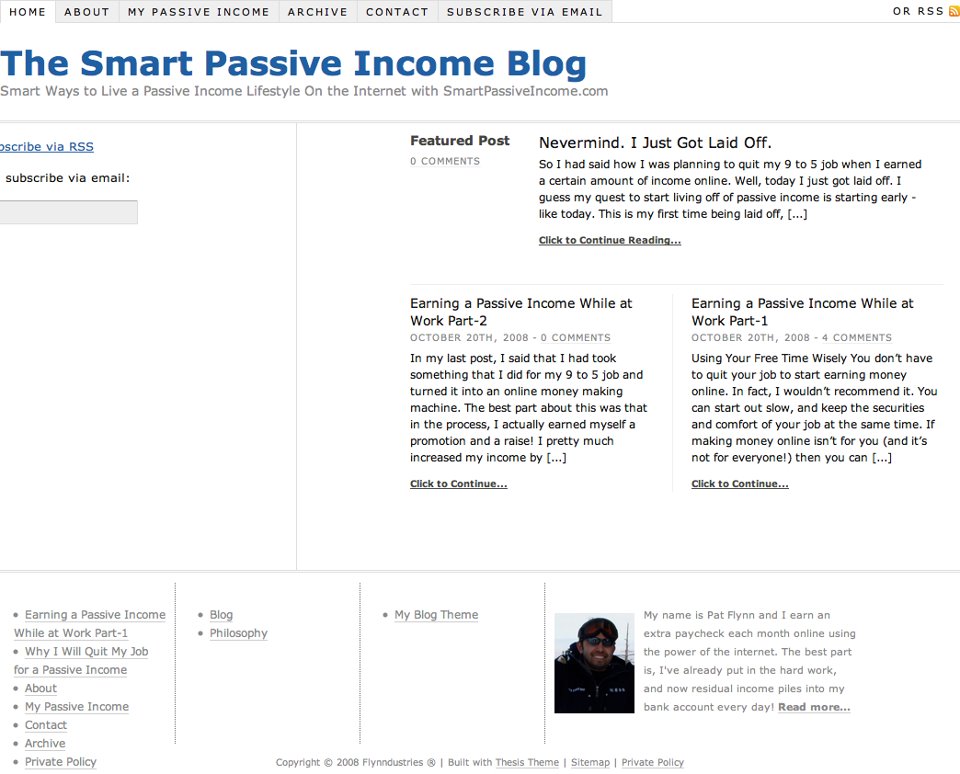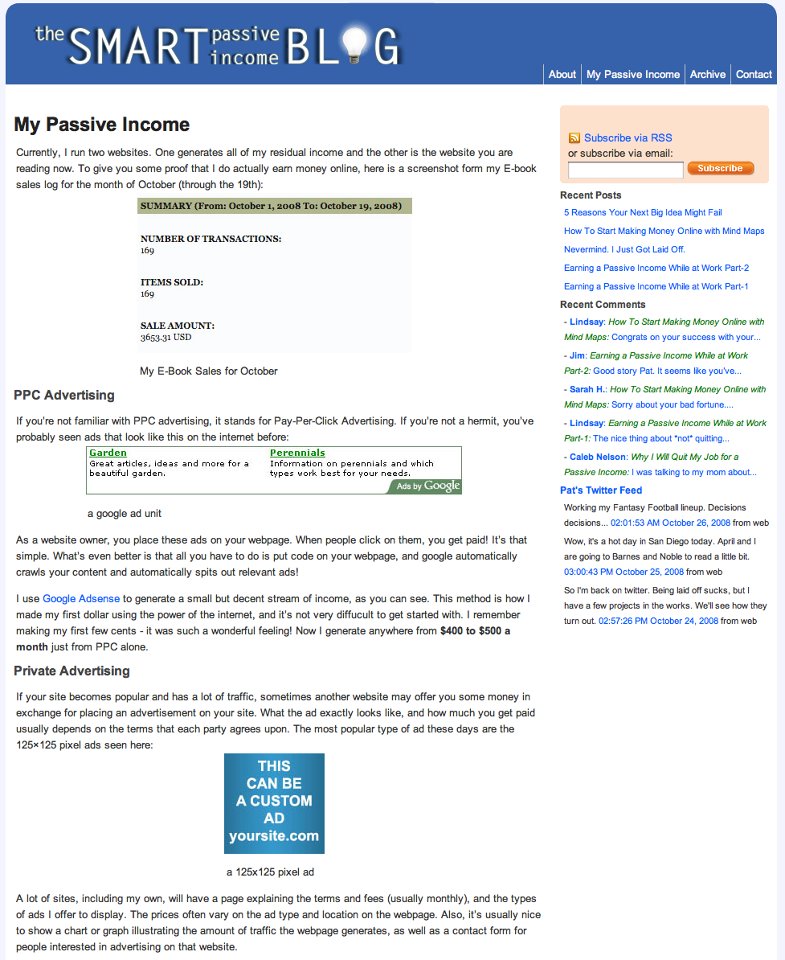Last Updated: February 15th, 2020
If you’re at all familiar with the world of marketing and creating your own self-sustaining business, you may have heard of him before…

Laid off from his job as a team captain at an architectural design firm In October 2008 (0ctober 21st, 2008 was the exact date), Pat Flynn has become the quintessential case study of someone who created a business on his own terms.
With some momentum built from the release of an eBook written to help people pass the LEED exam, in 2008, he launched his own website, Smart Passive Income – a website where he went on to document his experiments with passive income strategies along with detailing his earnings in a monthly income report.
In fact, thanks largely to the success of his eBook, the first installment of his income report series put him at $7,096.55 in net profit in October 2008, with the majority of his earnings coming from sale of the Green Exam Academy Exam eBook itself, and the remaining coming from a combination of Green Exam Academy Google Adsense ($596.31) and Green Exam Academy Private Advertising ($183.33).
If you aren’t familiar with Pat’s story, you can read more about it here. For a more expanded version, check out his About Page here. Or, in his book, Let Go, on Amazon.

After he popularized the transparency and authenticity captured in the publishing of a monthly income report, many other bloggers followed suite (see links to various income reports below under “transparency” section).
While Pat doesn’t necessarily write about the photography industry specifically, the general business topics covered on his blog, books, podcast, etc. means that there is most certainly application to the photography industry to be found in his content.
For ourselves, we have frequently referenced Pat Flynn’s writings (in particular) as they offer a lot of useful and often significantly detailed insight into the operation of the business.
Specifically, the underlying philosophy and approach he takes to operating his business(es) by actually putting consumers first is something really remarkable. The way he does this, at a very basic level, is by promoting the idea of creating valuable content and giving it away for free. While there are certainly “paywalls” in front of some of his products, the amount of useful information you can get from him without paying a dime is pretty substantial.
As it pertains to the photography industry, and in our case specifically – the wedding photography industry – we also know that work can sometimes dry up, particularly during the off season winter months. Opening your eyes to larger horizons to see the potential for other revenue streams is also another reason why we find Pat’s content so useful, and it has inspired us in many ways to start this blog as a result.
4 Lessons Learned From Pat Flynn That You Can Apply to Your Photo Business
Contained throughout the rest of this article will be a discussion of some of the key takeaways we have observed in Pat Flynn’s writings, and how you can apply them to your photography business.
Most of these lessons are actually quite simple, but how you act on them is equally, if not more, important.
#1). Be Authentic
Let’s begin by looking at what it means to be authentic. According to the dictionary, the word “authentic” means:
“adjective
- not false or copied; genuine; real: an authentic antique.
- having an origin supported by unquestionable evidence; authenticated; verified: an authentic document of the Middle Ages; an authentic work of the old master.
- representing one’s true nature or beliefs; true to oneself or to the person identified: a story told in the authentic voice of a Midwestern farmer; a senator’s speech that sounded authentic.”
Much has been written about regarding the act of being authentic. At it’s most simple form, real authenticity boils down to just being yourself.
In business, no matter the industry, there is a real importance in providing a product or service that effectively represents you as a person, or that you can get behind 100%. We all have had bad experiences with sales people who just want to make a sale vs. a sales person who you can tell is really enthusiastic because they like the product so much. There is a night and day difference, and it is telling.
Authenticity should play a significant role in your businesses identity. Some people even use the term “authentic” in their taglines. While this can come across as a little cliche in the modern photography industry (everyone seems to use this term), the people who truly act on this are the ones who represent what this word really means – and why it has the ability to be so powerful.
For ourselves, with Hand and Arrow Photography (our wedding photography business), we aim to keep our service and end product as authentic as possible. We do things that we can stand behind – not just things that have the potential to get us money.
We commit to some business practices, even if they don’t necessarily benefit us. We’ve had many conversations about whether or not to keep our wedding package pricing on our website, and while we can see both sides of the picture and why other photographers may not want to make these visible, it is something we keep on our site because we believe it provides more transparency – and maybe more importantly – because it’s something we would appreciate in a photographer if we were looking for one.
Stepping away from the photo industry, because of the value of authenticity in developing a brand – whether online, offline, or both – some variation of the word “authentic” has been captured in a number of book titles (or sub-titles), released specifically to detail development of a consistent brand image in light of heavy recent emphasis on social media. Just combing through Amazon’s releases, we we find an enormous list of content like this such as:
- Will the Real You Please Stand Up: Show Up, Be Authentic, and Prosper in Social Media
- Authentic: How to Be Yourself and Why It Matters
- Authenticity: What Consumers Really Want
- The Art of Authenticity: Tools to Become an Authentic Leader and Your Best Self
- Authenticity: The Head, Heart, and Soul of Selling
If you are interested in reading more about being authentic and the value it adds to your business brand, check out these articles:
If you want to read more of our thoughts on authenticity, check out our previous blog post, Its Not the Photography Industry – It’s the People Business, as this is something we actually discuss quite heavily there, too!
#2) Don’t be Afraid to Try Something New
Sometimes the “same old, same old” works.
In those cases, I would highly recommend continuing to do what you are doing with your photography business – and really anything else in life.
But…if what you are doing isn’t working, or if you think it could be done better, don’t hesitate to change things up.
In the years that we have been following Pat Flynn’s website, we’ve seen him grow as both an internet marketer and content creator.
Along with his own personal growth, we’ve also witnessed his experimentation with new things.
One such example is how his website itself has evolved over time. He even has an article about the different WordPress themes he has used over the years.
An analysis of the evolution of his website on Wayback Machine details a website that has changed dramatically since it was created in 2008 to now.
In fact, other than the name of the website, his website hardly looks the same from year to year; with almost everything about it changing -from logo, to layout, navigation, etc – everything has seen change.
In a variety of posts, over the years (usually just before the launch of a different iteration of his website), Pat explains more about all the reasons WHY he made any one particular change. If you are interested in reading these article–and, they are IMMENSELY valuable–you can read them at the links below:
Before we dive further, let’s look at all the different iterations of Smart Passive Income over the years…to do this, we will be displaying screenshots of his website as it has evolved over time.
- October 2008 – the earliest “snapshot” of his website available. In this article, Pat details how he built this first iteration of his website on the Thesis Theme framework. Yes, it looks pretty ‘bare bones’, with not a lot of “bells and whistles”. Pat explains that, the reason for this, is that he really just wanted to get a website up and running so that he could begin producing and publishing content right away, from day one. The major powerful underlying lesson we can learn from the first iteration of his website is that, if you have an idea for a website (whether it is related to photography or not)–and, you believe that others can benefit from it–you most certainly don’t need to have a website with a lot of complexities in design and graphics. Pat’s experience with his website is testament to the fact that you can start with a very modest website, and improve upon it over time (as you will see in the upcoming website iteration images).

- October 2008 – the second site version

- November 2008 – the third site version
- November 2009 – the fourth site version
- November 2010 – the fifth site version
- November 2011 – the sixth site version
- November 2015 – the seventh site version
- November 2016 – the eighth site version
- November 2017 – the ninth site version
There are some significant takeaways – even from just looking at the changes to his home pages as seen in these images.
While updates are likely consistently made, significant overhauls tend to happen only after longer term periods of one year or greater. This is likely due to the need to examine the backend data coming in to better see what is working and what isn’t.
From the early days of Pat’s website, it is obvious the site’s design is a little rough – likely leveraging very basic and free templates. While the content has been consistently good over the years – this first impression of how the site looks is very important. Over time, we can see how his website and personal brand image came to evolve. In it’s current version now in 2018 – we are immediately greeted by a professional portrait and other things that immediately indicate success in his niche. It’s a successful evolution, for sure!
With our own websites, while we haven’t necessarily made drastic changes in the look of them (yet!), we are always trying out new things on it. Some examples:
- Changing up the pricing of our wedding photography business packages
- Adding/removing tabs to navigation bar of website
- Experimenting with different color schemes and font types
In short – there is always a lot of space for growth and change. If you have a site already, you don’t necessarily need to go as far as completely changing your template, but small experiments can lead to big changes in time.
#3) Experiment with Different Types of Blog Posts
Since beginning Smart Passive Income, Pat has deliberately published different types of blog posts. The diversity in content comes in what the articles talk about (different components of business, marketing, etc.), as well as how these blog posts are constructed such as long form “pillar content”, shorter pieces, and so on.
As a side but related note in context of the building and developing a foundation of solid written article content for niche sites (as Pat Flynn built, developed, and experimented with himself), Jim and Ricky–the owners and creators of a number of high trafficked authority and niche websites, such as ImprovePhotography.com, CamperReport.com, CabinFreedom.com, DirtBikePlanet.com and IncomeSchool.com and also mentioned by us in this article–have frequently referenced Pat Flynn’s writing and podcasts as being very influential and inspirational to them even from the earliest days of their work.
In their YouTube video entitled How to Go Full-Time with Blogging in 24 Months (FULL WEBINAR), under their Secret #1 (on their Phase 1: The Seed slide, introduced at the 12:33 mark), Jim and Ricky unveil what they consider (based on years of trial and error, success and failure, of writing article content and building/developing niche and authority sites) to be the most effective context mix for gaining traffic to and growing a website (i.e. different types of blog posts).
Per their YouTube video, Jim and Ricky’s simple strategy of starting a new niche website includes feeding or injecting it with a total of (30) solid blog post articles consisting of the following breakdown that includes:
- Response Posts — 10 — These article posts fall between roughly 1,200 to 1,500 words. They answer a specific question that’s not competitive in the search results. When building their niche sites (as mentioned earlier, CamperReport.com, CabinFreedom.com, and DirtBikePlanet.com), Jim and Ricky suggest that the inspiration for these types of article posts typically come from simply being passionate about a topic and doing Google searches for your own questions–leading you to find if they have been adequately answered or not in the search results. If there is room to improve on existing search results displayed, there is definitely room to rank (and gain traffic) from the production of article posts such as these. Also, keyword research can be used to find questions that can be adequately addressed with the production of your own response article posts.
- Staple Posts — 10 — Examples of staple posts include Top 10 list posts, and other posts that are, by their very nature, shareable across a variety of social media outlets (think, Facebook, YouTube, Twitter, Instagram, etc).
- Pillar Posts — 10 — These types of article posts are at least 3,500 words. With the type of article posts, the intent is to go after more competitive keywords–oftentimes (and likely) going head-to-head against more established, authority, websites in your niche.
If you were to explore Pat Flynn’s website, SmartPassiveIncome.com, you would most assuredly find an assortment of each of these types of article posts.
This diversity in content is something we feel is strongly suited to the photography niche – and is frankly something underutilized on many photography-centric websites out there. One area where bloggers can get a little carried away is on the desire to make money through affiliate sales and advertising, and never really getting “deep” into the content they are promoting.
Of course, the most important thing in all of this to keep in mind is that – good and diverse content takes time to produce. Our approach to a large quantity of our articles on Formed From Light is to produce detailed articles that really cover in depth the topics we find to be important to talk about.
#4) Be Transparent
Closely related to authenticity is transparency.
We like to think of “transparency” as just one component of an effective brand – no matter what industry you are a part of.
Some of the ways in which Pat Flynn has fostered a transparent brand over the years include:

- Sharing intimate insights into his life. One of the places, on his website, where this is the most evident is on his About page. There you can see a picture of his family, along with various insights in his story/like/dislikes/intentions, etc.
- Providing monthly income reports. It gives a more intimate look into the more behind-the-scenes workings of the business, capturing the blogger’s experience in the moment, while also candidly exploring the blogger’s successes and failures.
- Transparency in affiliate marketing and advertising. As product are discussed in reviews and other articles where they are relevant, there is a large opportunity to display that particular product, as an affiliate link, which offers the opportunity for the blogger to capture clicks, direct readers to an affiliate website, and, ultimately, earn a commission for any sale. Being open about the use of these links is a valuable part of any online marketing strategy.
We could probably find many other areas where transparency is clearly visible if we wanted to dig further.
These particular elements showcase a really significant lesson to us.
In the online world, it is easy to be an anonymous force online – and sometimes this anonymity gives people the ability to do less-than-nice things. By putting yourself on display, you instantly become more relatable, and it forces you to be placed under a microscope by your audience. You can’t expect everyone to always get along or agree with the stances you take on certain things, but by being open and honest, you can better showcase things that are (or aren’t) working for you – and construct better content as a result.
As an example of transparency in action, as it relates directly to the photography industry, we can turn to Tim Ferris, NY Times Best-Selling Author of The 4-Hour Workweek, The 4-Hour Chef, and The 4-Hour Body, who wrote the book entitled Tools of Titans from which we quote below:
“..If I look across and everyone else is doing X, how do you zig when everyone else is zagging? The way that I zigged when everyone else was zagging in photography was I chronicled my exploits of learning my craft…It was 10 years before it was cool to be transparent, and I was actually vilified for sharing trade secrets.”
With all this said, there is one caveat we want to discuss regarding transparency, too: never talk about aspects of your life you are not comfortable sharing.
Certain things like very private information such as your address, phone number, etc. will, more than likely, never be needed to give away. Other details can be more subjective – but keep in mind that if you let out that you have a disease, it’s possible this could be discussed about in the future by random people on the internet, and even used against you in some capacity by the trolls of the internet.
We look at the stories like that of John ‘TotalBiscuit’ Bain, a YouTube star who recently passed away from cancer. While his discussions of his illness over the years have always been directed towards raising awareness (a great thing, mind you!), he also received a lot of negative comments from people as well. While he appeared to handle these comments with ease, some people may not have as easy of a time.
How to Apply These Lessons to Your Photography Business
Pat Flynn is an excellent model for success in business, and showcases that it is entirely possible to grow something very successful from very humble beginnings. The lessons we have learned throughout the years as a result of his content form fundamental aspects of our own business philosophy.
While we have discussed some of the applications of these lessons to our own business, we wanted to add another section to this article to expound a little bit more with the intention of helping you directly better see how these things can be leveraged as a part of your own photography business.
One of the key tenants we live by when it comes to our business is to simply replicate success.
The great thing about powerful brands that have opted to be authentic, transparent, and so on is that we can better analyze what they have done in order to achieve similar success ourselves.
We know authenticity, trying something new, experimentation, and transparency are all major parts of business now because they have effectively changed the lives of many small business owners. We act on these things ourselves over and over again, and continue to reap the benefits of taking risks and being honest about our experiences.
Our Expanded Tips for How You Can Be A Transparent & Authentic Business Owner:
Think for a moment about what defines you as a person.
What makes you who you are?
Your authentic brand image begins with yourself.
As photographers, the services we sell are actually much less about the photos we create – but our own personalities. While, of course, people will look through your portfolio to get a sense of whether or not you are a good fit for their visual aesthetic – the actual “sales” portion of things often will boil down to chemistry between you (a business owner) and the prospective client.
In order to attract your ideal clients, the best starting point is to list out attributes of yourself that you would like people to know about – and even have in common.
For us, some simple ones include listing off things we enjoy doing like:
- hiking
- creating music
- traveling
- home renovations
Other personal attributes include:
- our adventurous spirits
- our levelheadedness
- our calm demeanors
One simple example of how we have practiced authenticity in our photography business (and how you can, too!) is by including either pictures of one (or both) of us, or pictures we have taken ourselves, within our article content. While stock photographs can be of very high quality, and can capture an idea or concept beautifully through an image, there is no substitute for using authentic pictures that show your own feelings and emotions ‘in the moment’ (this is exactly why, in many cases, quality of image has taken a backseat to authenticity captured in quick photographs, like selfies.)
In our various camera gear and equipment reviews articles, we have made it common practice to use pictures we have actually taken ourselves:
- Our Review of the Canon 135mm f/2 Camera Lens
- Review: Profoto A1 AirTTL-C Studio Flash – Is It Worth the Hype?
- The Best Canon 135mm Camera in Photography Money Can Buy
- Profoto B1X 500 Air-TTL Flash – Review
- Canon 5D Mark IV Review Through the Eyes of Two Wedding Photographers
- Our Review of the Canon 85mm f/1.2 II Camera Lens
- Is the Canon EF 70-200mm f/2.8L IS II USM Telephoto Zoom Lens the Best Wedding Photography Lens?
- Essential Equipment for Wedding Photographers
- Our Review of the Canon EF 24mm f/1.4L II Camera Lens
Likewise, we have written a number of articles where we include pictures of ourselves (usually interacting in some way, shape, or form, with the camera gear and equipment we have actually purchased and used ourselves). Here are some examples:
- What Photography Gear Should I Bring to Iceland?
- Our Review of the Canon EF 50mm f/1.2 L USM Lens
- Summertime Backyard Self-Portraits | Lehigh Valley Photographers
- Traveling Iceland – Day 2 – Snaefellsnes Peninsula
- Kuku Campers – Campervan Rental Iceland – Review
- Reflection On Our 10 Day Adventure in Iceland – One Year Later
By putting on display these components of who you are – whether directly through your branding or advertising, or less directly just by the way you act and things you talk about when meeting with prospective clients – you are putting on your authentic self.
Our Expanded Tips for How You Can Try Something New With Your Business
Telling someone to “try something new” is easy to do. Actually acting on this – well, it can be challenging sometimes.
One of the most difficult places to get away from is a really nice comfort zone. Unfortunately, it is in this place that we often limit our potential.
As business owners, we often are forcing ourselves to push our own boundaries in ways we wouldn’t have expected. In our day jobs (in corporate America, mind you), we often can feel stuck in a rut and not too inspired – often as a result of limitations in job growth and just due to the specific company needs at the moment.
With a small business, there is no limiting factor. Being the one in control, you get to call the shots. This is a great feeling, really!!
As photographers, business owners, bloggers…trying something new is quite easy and natural for us. New things take many shapes – most of which are not expensive, and many of which aren’t super time intensive.
No doubt, things that cost a lot of money or require a lot of time…also need more thought before jumping the ship. But some things that are easy – well, these are worth taking the risk to start.
For ourselves, some things we have done in recent years include:
- Traveling and documenting our travels for blog posts such as our Reflection on 10 Days Spent in Iceland
- Experimenting with styled shoots to expand our portfolio and network with other vendors
- Change our approach to social media by leveraging a post scheduler (Later)
- Expand our branding graphics and integrate on our website
- Try different price points for photography packages (some seemed to work, others not so much)
The best way to start this for yourself is to simply write down a list of things you want to achieve with your business – and begin to identify practical things you can do, some short-term and some long-term, and start making a plan to act on these things.
Our Expanded Tips for How You Can Experiment With Blog Posts
The last section of this article will talk about blog content in more depth.
We have been blogging for a long time – not so much on this current website, but on many past websites we have worked on such as Hand and Arrow Photography, Plant Smart Living, etc.
If you are not blogging already, we would like to encourage you to start.
In the short term, writing blog posts for your clients (and prospective clients) is a great way to convey your thoughts on different subjects that may be relevant to them. For example, a popular post like this we wrote our our photography business website is What is a “Day After” Session? where we detail just that…what a Day After session looks like!
Longer term, blogging (when done well) has a lot of potential drive new visitors to your website from anywhere in the world – and you can also monetize your writings with affiliate links and other forms of advertising. As photographers, this can be hugely beneficial as a means of increasing your yearly earnings, especially during the slow times when you don’t have a lot to shoot.
Once you begin blogging, experimentation often comes naturally if you let it.
Experiment with different post types (How To’s, Top 10 Lists, Reviews, Personal Stories, etc.), as well as how you structure your content. Over time, by leveraging analytics data, you can better gauge what is working and what isn’t – and refine your approach.
Conclusion
We have learned a lot from Pat Flynn and Smart Passive Income. While he is not a photographer, his business sense and website serves as a great source for information that can be applied to all types of businesses.
We hope you are able to take some of the lessons and insights put together here to heart, and find ways to integrate them into your own photography business.